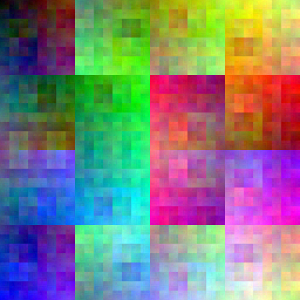Hello. I’m Christian Perfect and it’s finally here: Aperiodical Round Up 6!
It’s certainly been a while since the last Round Up. You might not even have the words to describe just how long it’s been. Maybe the book Naming Infinity will help.
Mathematical truths aren’t only revealed through mystical experiences to weirdo monks in the Russian Steppe — sometimes you can see them with your own eyes! For example, brine shimp need remain a mystery no longer because now Science has allowed you to see the vector fields they produce when flapping their ridiculous little limbs about:
[youtube url=http://www.youtube.com/watch?v=w8WG0W_U0jc]
And in case you’re ever trapped in a room with just a sheet of paper, a pair of scissors and some Sellotape, don’t despair! And don’t bother trying to McGyver an escape either; make a model of the $\{7,3\}$-tiling of the hyperbolic plane instead. Because after all, the best way to turn a frown upside down is to move to a space with negative curvature.
Now that you’re comfortable with the hyperbolic plane, solving an infinite 3D hyperbolic version of Rubik’s Cube should be a doddle.
Let’s move from enlightening visualisations of abstract truth to the distinctly less rigorous world of data visualisations. Aldo Cortesi has produced a wonderful selection of visualisations of various computery things using the Hilbert curve. On the right is his Hilbert-curve traversal of Mac OS X’s ksh binary, with values mapped to a Hilbert-curve traversal of the RGB colour cube. He has also made some pretty pictures of sorting algorithms in action and this beautiful depiction of the Hilbert curve itself:
Have you ever wondered how Conway’s Game of Life would look on a torus? Well, wonder no more, for it exists. The answer is rather disappointing – it doesn’t look great. Definitely a candidate for application of the recent isometric 3d embedding of the flat torus.
So much visualisation! Your visual cortex must be close to overheating now. Well, I’m bringing the heat with CourtVision Analytics, “examining the NBA through spatial and visual analytics”, featuring articles such as “Breaking Down Chris Paul” and “The Sad MicroGeography of Rajon Rondo“.
[youtube url=http://www.youtube.com/watch?v=X7dFMbubxr4]
Making origami is a pretty excellent way to live your life. If you’ve decided to pursue that worthy vocation, I have a few links that might help you. “Yes yes, you’ve probably got some patterns for origami polyhedra,” I hear you say, “but I’ve always wanted to fold a surface of revolution and I bet you can’t help me there.” Ever so sorry to disappoint/delight, but there help you I can. I present “ORI-REVO, a Design Tool for 3d Origami of Revolution“. Watch in awe as ply-master Jun Mitani twists three boxes from a single sheet:
[youtube url=http://www.youtube.com/watch?v=UVcQF-81fBI]
At last year’s big MathsJam, Costel Harnasz showed us a way of producing a paper heart with a single cut of a folded piece of paper. I was overjoyed to discover the artform’s Orson Welles, Erik Demaine. He has shown that any pattern of straight-line cuts in a piece of paper can be made by folding and a single complete straight cut. He has written a nice page on the subject with some attractive examples, a little bit of history, and some links to further reading. Following the crease patterns is an intellectual exercise in itself, but worth the effort. I made a butterfly!
Finally on the subject of folded paper, if you’ve got a couple of hours to spare, make a magic ball.
I’ve often wondered if a door-to-door circular slide rule business would have been feasible in the time of the Emperor Hadrian. There are many logistical factors to consider, which is why I was happy to learn of the ORBIS project to create a geospatial network model of the Roman world. Here’s a taster:
The model allows for fourteen different modes of road travel (ox cart, porter, fully loaded mule, foot traveler, army on the march, pack animal with moderate loads, mule cart, camel caravan, rapid military march without baggage, horse with rider on routine travel, routine and accelerated private travel, fast carriage, and horse relay) that generate nine discrete outcomes in terms of speed and three in terms of expense for each road segment.
As well as roads, the Romans have a reputation for laying down the law. Aiming to out-pax the Pax Romana is the MaSC group at UCLA, who are doing some really fascinating stuff with modelling crime in hopes of promoting enlightened policing. They were written up recently in an article in the Sydney Morning Herald with the predictably rubbish title “Formula for laying down the law“.
There are lots of tilings of the plane. Loads and loads. More than a googol, even, which is why it’s good to have a tool to search through them. (You have to have seen what I did there. Did you? I’m very proud.) tilingsearch.org provides exactly that service, including a choose-your-own adventure search method.
Sometimes, I suffer from what I call arithmagnosia – I encounter a number in decimal form that looks familiar but whose symbolic form I can’t quite place. Step forward please, the Inverse Symbolic Calculator. If you give it a number in decimal form, it’ll have a guess at the simplest, closest combination of fractions, surds and constants. Or, you could write them out acrophonically and see if they say anything inspiring.
These days, the science of finding Turing-complete systems has advanced to the point where I’m more often surprised when I find that something isn’t Turing-complete than otherwise. It seems that even your precious bodily fluids aren’t safe: water has jumped on the universal computation bandwagon thanks to Bernard Gitton’s Eaurdinateur.
The next sentence is false. The paradox created by the previous, true sentence will be resolved by one of our operators in time for the next edition of the Aperiodical Round Up. For now, please hold:
[youtube url=http://www.youtube.com/watch?v=boJD_gTLavA]



